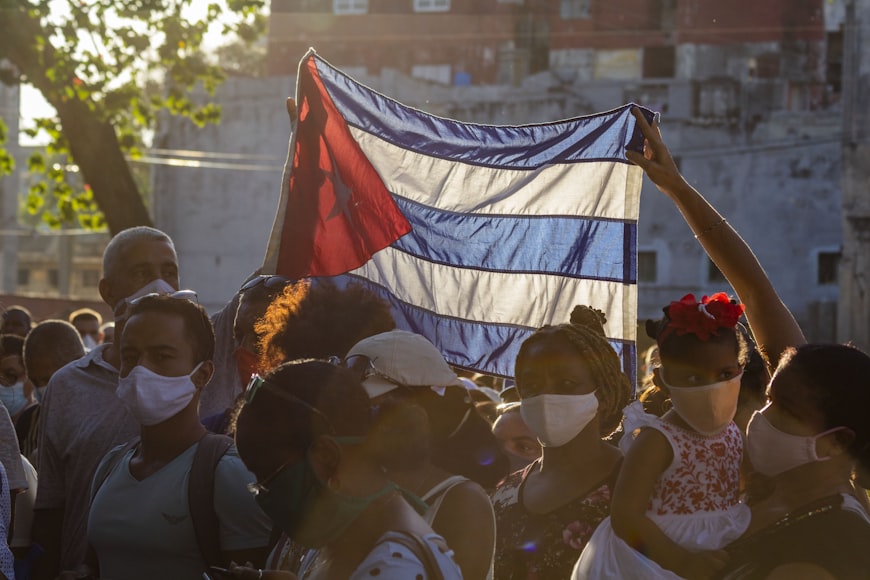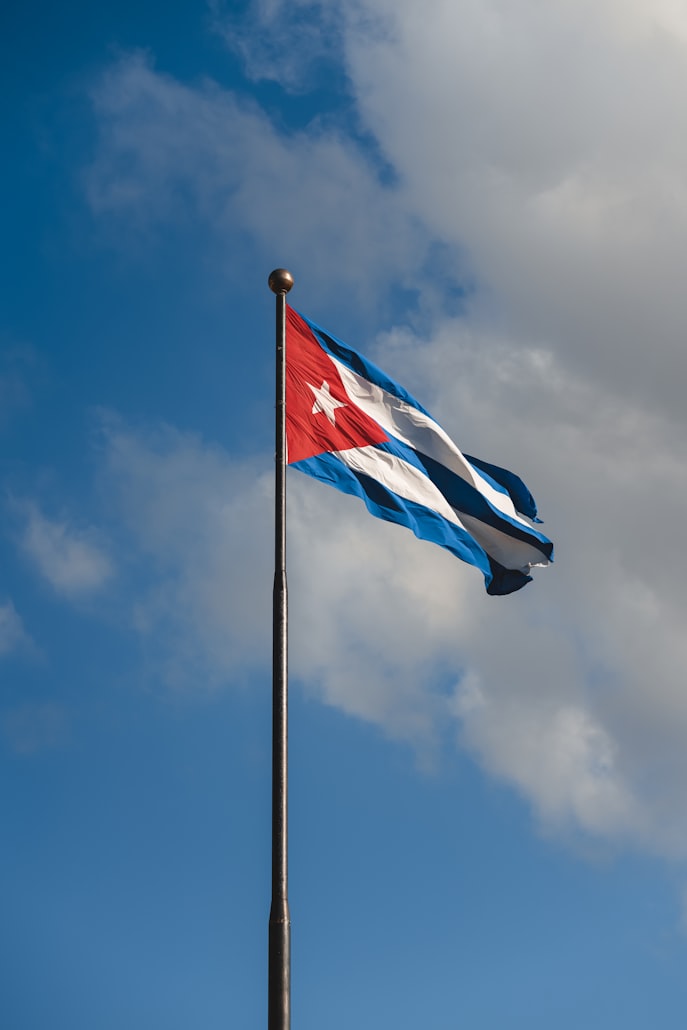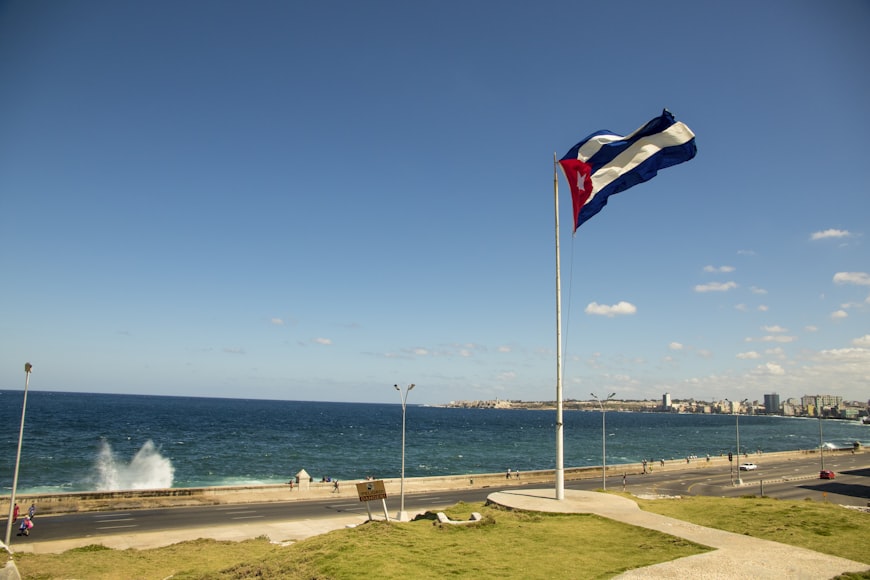Cuba flag: Symbol of liberty for Cubans against colonialism
The Cuba flag, known as the “Estrella Solitaria” (Lone Star) or “La bandera cubana” (The Cuban banner), is a powerful symbol woven into the fabric of the nation’s history. Its vibrant colors and unique design tell a tale of struggle, independence and the unwavering spirit of the Cuban people.
This article delves into the history, symbolism and significance of the Cuban flag, exploring its journey from a revolutionary banner to a national emblem.
Table of Content hide 1 What is Cuba’s flag? 2 Cuba flag history 3 Cuba flag meaning 4 Cuba flag coloursWhat is Cuba’s flag?

The flag of Cuba is a distinctive symbol representing the nation’s identity, history and aspirations. Its design comprises five horizontal stripes: three blue and two white, with a red equilateral triangle on the hoist side containing a white five-pointed star.
The Cuban flag adheres to a length-to-width ratio of 2:1, ensuring a balanced and proportionate design. The alternating blue and white stripes, which were sky blue before 1959, maintain equal width throughout the flag’s length.
The red chevron, forming an equilateral triangle, is a prominent feature on the hoist side of the flag. Within this chevron, a white five-pointed star is positioned at the midpoint of the flag’s height. The star’s diameter is one-third of the flag’s hoist length, ensuring a harmonious placement and proportion within the overall design.
The flag’s origins trace back to the mid-19th century when Narciso López, a Cuban revolutionary, designed and hoisted it during his attempts to liberate Cuba from Spanish colonial rule. The flag gained prominence during various independence movements, including the Ten Years’ War and the Cuban Revolution.
Miguel Teurbe Tolón, a poet, played a significant role in designing the flag, drawing inspiration from López’s vision. His wife, Emilia Teurbe Tolón, sewed the first flag. Over time, the flag became a powerful emblem of Cuban nationalism, resilience, and the ongoing struggle for freedom.
Despite political changes over the years, including the establishment of a communist state after the 1959 Cuban Revolution, the flag has remained unchanged, serving as a symbol of continuity and national pride.
ALSO READ: Colombia flag: Emblem of history, symbolism and national pride
Cuba flag history

In his resistance against the Spanish Crown alongside Venezuela’s rebel armies, Narciso López relocated from his birthplace of Caracas to Havana, Cuba.
Due to his involvement in anti-colonial activities, he was compelled to live in exile. By 1849, he had resettled in New York City, USA, where he continued his efforts to support an independent Cuba.
Miguel Teurbe Tolón, a poet, collaborated with Lopez in creating the flag, drawing inspiration from López’s vision. The first flag was sewn by Emilia Teurbe Tolón, the wife of Tolón. López and Tolón, along with José Aniceto Iznaga Borrell, López’s nephew; José María Sánchez Iznaga, Cirilo Villaverde and Juan Manuel Macías, collectively settled on the final design: Two white stripes, three blue stripes, a red triangle and a solitary star.
In 1850, López attempted a coup using the same flag to free Cuba from Spanish rule but the attempt failed. The town of Cárdenas witnessed the first raising of the lone star flag on May 19, 1850, during its capture by Cuban rebels.
A year into the Ten Years’ War, the inaugural Constituent Assembly of the Republic of Cuba convened in Guáimaro, Camagüey Province. The assembly deliberated on two profoundly symbolic flags: The Demajagua, akin to the Chilean flag – conceived by Carlos Manuel de Céspedes to ignite the war of independence – and López’s Lone Star.
The latter was chosen as López had initiated Cuba’s freedom struggle. While the Demajagua flag wasn’t discarded, it was preserved in the House of Representatives as part of the national heritage.
On May 20, 1902, following Cuba’s official transition to an independent republic, Generalissimo Máximo Gómez raised the flag atop the Tres Reyes del Morro castles in Havana. This act signified the culmination of the Cuban revolution and the end of the fight for Cuban independence.
Both the flag and the coat of arms were crafted by Miguel Teurbe Tolón. Their designs were officially decreed by Cuba’s first president, Tomás Estrada Palma, on April 21, 1906. Since then, the flag has remained unchanged.
In 2019, Cuba introduced the “National Symbols Bill” to allow more flexible usage of these symbols to enhance their presence in society within a respectful legal framework. The bill permits the flag’s use for promotional purposes only if the messages contribute to nurturing patriotic values and fostering respect and reverence for the nation’s historical heritage.
However, artists from the San Isidro Movement protested against restrictions imposed by the Cuban government and the arrest of artist Luis Manuel Otero Alcántara under this new law, launching a campaign with the hashtag “#LaBanderaEsDeTodos” (The Flag Belongs to Everyone).
Cuba flag meaning

Below is a detailed explanation of each of the flag’s components:
- The Blue Stripes: Cuba was once divided into three Spanish military districts. The three horizontal blue stripes represent these former divisions, reminding the nation of its colonial past and the unification fight. Additionally, the blue evokes the immensity and serenity of the Caribbean sky, a constant companion in the lives of Cubans.
- The White Stripes: Flanking the blue stripes are two white stripes, symbolising the purity of the Cuban patriots’ cause. They represent the desire for a clean break from colonial rule, a nation built upon ideals of freedom and unblemished by the injustices of oppression.
- The Red Triangle: The red triangle embodies strength, constancy and influences from Masonic ideals (as triangles were commonly associated with Masonic symbolism. It reflects ideals of equality and was present in various flags across the former Spanish empire). At the heart of the red triangle lies a solitary white, five-pointed star, aptly named the “Estrella Solitaria” (Lone Star). This star embodies several profound meanings:
- Star: Unlike the numerous stars adorning the flags of many colonial powers, the single star highlights Cuba’s unique identity and its yearning for freedom. It signifies the nation’s desire to forge its path, independent of foreign domination. The five points of the star have been associated with divinity and hope. They represent the aspirations of the Cuban people for a brighter future, guided by faith and a yearning for a better tomorrow.
- Light in the Darkness: The star, positioned against the red background, can also be interpreted as a beacon of hope shining through the darkness. It symbolizes the perseverance of the Cuban spirit in the face of adversity.
ALSO READ: Haiti flag: Symbol of national freedom, strength of the Haitian people
Cuba flag colours

The flag features five horizontal stripes alternating in colour between blue and white.
It also evokes the blue of the Caribbean sky, a constant presence in the lives of the Cuban people. The white stripes symbolise the purity of the Cuban patriots’ cause and their desire for a clean break from colonial rule.
Atop the blue and white stripes lies a red equilateral triangle positioned on the left-hand side of the flag, closest to the flagpole. This triangle signifies the blood spilt in the fight for independence and serves as a reminder of the sacrifices made by countless Cubans in their pursuit of liberty.
At the centre of the red triangle resides a solitary white, five-pointed star. This star, the “Estrella Solitaria”, embodies Cuba’s unique identity and its yearning for freedom. As the only star on the flag, it starkly contrasts the numerous stars adorning the flags of many colonial powers, highlighting Cuba’s desire to forge its path.
ALSO READ: Pakistan flag: Symbol of faith, progress for Pakistani people
ncG1vNJzZmivp6x7tLfAm5isoF6YvK57wq6ZmmWWoa6oew%3D%3D